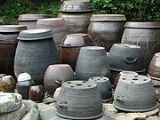
Tteok
Encyclopedia
Tteok (t͈ʌk; also spelled ddeock, duk, dduk, ddeog, or thuck) is a class of Korea
n rice cake
s made with glutinous
rice flour
(also known as sweet rice or chapssal), by steaming. Normal rice flour
can be used for some kinds of tteok. There are hundreds of different kinds of tteok eaten year round. In Korea it is customary to eat tteok guk
(tteok soup) on New Year's Day
and sweet tteok at weddings and on birthdays. It is often considered a celebratory food and can range from rather elaborate versions with nuts and fruits down to the plain-flavored tteok used in home cooking. Some common ingredients for many kinds of tteok are mung bean, red bean
, and sweet red bean paste
, Korean mugwort, jujube
and other dried fruits, sesame seeds and oil, sugar, and pine nuts.
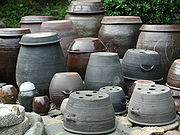
 The below are cooking untensils to make tteok in the traditional Korean way.
The below are cooking untensils to make tteok in the traditional Korean way.
flour in "siru" (시루), or a large earthenware
steamer, so it is often called "sirutteok" (시루떡). It is regarded as the basic and oldest form of tteok. The pounded tteok is made by using a pounding board or mortar after steamed first. In making pan-fried tteok, the rice dough is flattened like a pancake
and pan-fried with vegetable oil. The shaped tteok are made by kneading a dough with hot water which is usually shaped into balls.
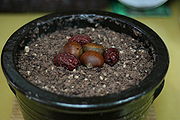 The main ingredients for steamed tteok or "sirutteok
The main ingredients for steamed tteok or "sirutteok
" are rice
(맵쌀, maepssal in Korean) or glutinous rice
(찹쌀 chapssal) and sometimes they are mixed together. In some cases, other grains, beans (azuki bean
s or mung bean
s), sesame
seeds, wheat flour
, or starch
can be mixed with the rice. Various fruit
s and nuts are used as subsidiary ingredients, such as persimmon
s, peach
es or apricot
s, chestnut
s, walnut
s, and pine nut
s. In addition, vegetables with flavors or herbs can be used to flavor the tteok. Danggwi leaves (Ostericum grosseserratum), seogi
mushroom (manna lichen
), daikon
, artemisia, pepper
, and cheongju
are the most common flavorings, and honey and sugar are used as sweeteners
.
In order to make steamed tteok or sirutteok, rice or glutinous rice is soaked in water for a while, then ground. The prepared rice flour is put in a siru and steamed. According to steaming method, sirutteok
is subdivided into two groups; seolgitteok (설기떡) is shaped into a single large lump whereas kyeotteok (켜떡) consists of multiple layers with azuki bean
powder or other bean powder. Seolgitteok is also called muritteok (무리떡), regarded as the most basic form of sirutteok made only with rice. On the hand, in making kyeotteok, rice and glutinous rice are mixed. The name of kyeotteok derives from the adverb kyeokeyo (켜켜, literally "filed") in Korean because the tteok is made as such.
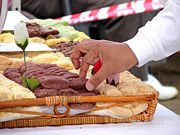 In the traditional preparation, pounded tteok is made by pounding rice or glutinous rice with utensils called jeolgu and jeolgutgongi or tteokme and anban. Injeolmi
In the traditional preparation, pounded tteok is made by pounding rice or glutinous rice with utensils called jeolgu and jeolgutgongi or tteokme and anban. Injeolmi
(tteok coated with bean powder), garaetteok (가래떡 cylinder-shaped white tteok), jeolpyeon (절편 patterned tteok) and danja (단자 glutinous tteok ball coated with bean paste)” are commonly eaten pounded tteok.
Rice and glutinous rice are peeled off to make grain particles or powder, and steamed in a siru (earthenware steamer) and then pounded with the untensils. The pounded tteok is divided into glutinous pounded tteok (찹쌀도병 chapssal dobyeong) and non-glutinous pounded tteok (맵쌀도병 mapssal dobyeong) by rice type. Injeolmi that is a representative of the glutinous pounded tteok has varieties in accordance with gomul types (고물, coating made with bean powder, sesame seeds, or sliced jujubes) or subsidiary ingredients mixed into the steamed rice while pounding on the anban. Patinjeolmi (팥인절미), and kkaeinjeolmi (깨인절미) are the examples for the former, coated with red bean powder and sesame respectively. In ssuk injeolmi (쑥인절미) and surichwi injeolmi (수리취인절미) are ssuk (Artemisia princeps var. orientalis
) and surichwi (Synurus deltoides (AIT.) NAKAI
) added.
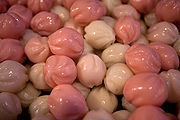
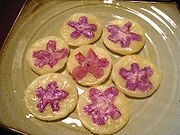
Korea
Korea ) is an East Asian geographic region that is currently divided into two separate sovereign states — North Korea and South Korea. Located on the Korean Peninsula, Korea is bordered by the People's Republic of China to the northwest, Russia to the northeast, and is separated from Japan to the...
n rice cake
Rice cake
A rice cake may be any kind of food item made from rice that has been shaped, condensed, or otherwise combined into a single object. A wide variety of rice cakes exist in many different cultures in which rice is eaten, and are particularly prevalent in Asia. The origin of rice cake seems to be...
s made with glutinous
Glutinous rice
Glutinous rice is a type of short-grained Asian rice that is especially sticky when cooked. It is called glutinous Glutinous rice (Oryza sativa var. glutinosa or Oryza glutinosa; also called sticky rice, sweet rice, waxy rice, botan rice, biroin chal, mochi rice, and pearl rice, and pulut) is a...
rice flour
Rice flour
Rice flour is a form of flour made from finely milled rice. It is distinct from rice starch, which is usually produced by steeping rice in lye....
(also known as sweet rice or chapssal), by steaming. Normal rice flour
Rice flour
Rice flour is a form of flour made from finely milled rice. It is distinct from rice starch, which is usually produced by steeping rice in lye....
can be used for some kinds of tteok. There are hundreds of different kinds of tteok eaten year round. In Korea it is customary to eat tteok guk
Tteok guk
Tteokguk is a traditional Korean dish eaten during the celebration of the Korean New Year. The dish consists of the broth/soup with thinly sliced rice cakes . It is tradition to eat tteokguk on New Year's day because it is believed to grant the consumer luck for the forthcoming year and gain an...
(tteok soup) on New Year's Day
Korean New Year
Korean New Year, commonly known as Seollal , is the first day of the lunar calendar. It is the most important of the traditional Korean holidays. It consists of a period of celebrations, starting on New Year's Day. Koreans also celebrate solar New Year's Day on January 1 each year, following the...
and sweet tteok at weddings and on birthdays. It is often considered a celebratory food and can range from rather elaborate versions with nuts and fruits down to the plain-flavored tteok used in home cooking. Some common ingredients for many kinds of tteok are mung bean, red bean
Azuki bean
The is an annual vine, Vigna angularis, widely grown throughout East Asia and the Himalayas for its small bean. The cultivars most familiar in north-east Asia have a uniform red color, but white, black, gray and variously mottled varieties are also known. Scientists presume Vigna angularis var...
, and sweet red bean paste
Red bean paste
Red bean paste or Azuki bean paste is a sweet, dark red bean paste originating from China. It is used in Chinese cuisine, Japanese confectionery, and Korean cuisine. It is prepared by boiling and mashing azuki beans and then sweetening the paste with sugar or honey...
, Korean mugwort, jujube
Jujube
Ziziphus zizyphus , commonly called jujube , red date, Chinese date, Korean date, or Indian date is a species of Ziziphus in the buckthorn family Rhamnaceae, used primarily as a fruiting shade tree.-Distribution:Its precise natural distribution is uncertain due to extensive cultivation,...
and other dried fruits, sesame seeds and oil, sugar, and pine nuts.
Utensils for making tteok


- Ki (키), winnowing vessel
- Inambak (이남박), rice-washing bowl
- Bagaji (바가지), gourd-like dipper
- Ongbaegi (옹배기) and jabaegi (자배기), large, round pottery bowls
- Che (체) and chetdari (쳇다리), sieve and sieve-frame legs
- Maetdol (맷돌), grinding stone
- Jeolgu (절구) and jeolgutgongi (절굿공이), mortar and pestleMortar and pestleA mortar and pestle is a tool used to crush, grind, and mix solid substances . The pestle is a heavy bat-shaped object, the end of which is used for crushing and grinding. The mortar is a bowl, typically made of hard wood, ceramic or stone...
- Anban (안반) and tteokme (떡메), wooden pounding board and malletMalletA mallet is a kind of hammer, usually of rubber,or sometimes wood smaller than a maul or beetle and usually with a relatively large head.-Tools:Tool mallets come in different types, the most common of which are:...
video - Siru (시루) and sirumit (시루밑), earthenware steamer and mat placed in the bottom of the siru
- Sot (솥) and geonggeure (겅그레), cauldronCauldronA cauldron or caldron is a large metal pot for cooking and/or boiling over an open fire, with a large mouth and frequently with an arc-shaped hanger.- Etymology :...
and steaming rack - Beoncheol (번철), thick frying pan
- Chaeban (채반), wicker tray
- Tteoksal (떡살), wooden tteok pattern stamp
Types
Tteok are largely divided into four categories, such as "steamed tteok" (찌는 떡), "pounded tteok" (치는 떡), "boiled tteok" (삶는 떡) and "pan-fried tteok" (지지는 떡). The steamed tteok is made by steaming rice or glutinous riceGlutinous rice
Glutinous rice is a type of short-grained Asian rice that is especially sticky when cooked. It is called glutinous Glutinous rice (Oryza sativa var. glutinosa or Oryza glutinosa; also called sticky rice, sweet rice, waxy rice, botan rice, biroin chal, mochi rice, and pearl rice, and pulut) is a...
flour in "siru" (시루), or a large earthenware
Earthenware
Earthenware is a common ceramic material, which is used extensively for pottery tableware and decorative objects.-Types of earthenware:Although body formulations vary between countries and even between individual makers, a generic composition is 25% ball clay, 28% kaolin, 32% quartz, and 15%...
steamer, so it is often called "sirutteok" (시루떡). It is regarded as the basic and oldest form of tteok. The pounded tteok is made by using a pounding board or mortar after steamed first. In making pan-fried tteok, the rice dough is flattened like a pancake
Pancake
A pancake is a thin, flat, round cake prepared from a batter, and cooked on a hot griddle or frying pan. Most pancakes are quick breads; some use a yeast-raised or fermented batter. Most pancakes are cooked one side on a griddle and flipped partway through to cook the other side...
and pan-fried with vegetable oil. The shaped tteok are made by kneading a dough with hot water which is usually shaped into balls.
Steamed tteok

Sirutteok
Sirutteok is a type of Korean rice cake traditionally made by steaming rice or glutinous rice flour in a "siru" , a large earthenware vessel used for steaming which gives "sirutteok" its name. "Sirutteok" is regarded as the oldest form of tteok in Korean history.-Preparation:Sirutteok is made by...
" are rice
Rice
Rice is the seed of the monocot plants Oryza sativa or Oryza glaberrima . As a cereal grain, it is the most important staple food for a large part of the world's human population, especially in East Asia, Southeast Asia, South Asia, the Middle East, and the West Indies...
(맵쌀, maepssal in Korean) or glutinous rice
Glutinous rice
Glutinous rice is a type of short-grained Asian rice that is especially sticky when cooked. It is called glutinous Glutinous rice (Oryza sativa var. glutinosa or Oryza glutinosa; also called sticky rice, sweet rice, waxy rice, botan rice, biroin chal, mochi rice, and pearl rice, and pulut) is a...
(찹쌀 chapssal) and sometimes they are mixed together. In some cases, other grains, beans (azuki bean
Azuki bean
The is an annual vine, Vigna angularis, widely grown throughout East Asia and the Himalayas for its small bean. The cultivars most familiar in north-east Asia have a uniform red color, but white, black, gray and variously mottled varieties are also known. Scientists presume Vigna angularis var...
s or mung bean
Mung bean
The mung bean is the seed of Vigna radiata. It is native to the Indian subcontinent.-Description:They are small, ovoid in shape, and green in color...
s), sesame
Sesame
Sesame is a flowering plant in the genus Sesamum. Numerous wild relatives occur in Africa and a smaller number in India. It is widely naturalized in tropical regions around the world and is cultivated for its edible seeds, which grow in pods....
seeds, wheat flour
Wheat flour
Wheat flour is a powder made from the grinding of wheat used for human consumption. More wheat flour is produced than any other flour. Wheat varieties are called "clean," "white," or "brown" if they have high gluten content, and they are called "soft" or "weak" flour if gluten content is low...
, or starch
Starch
Starch or amylum is a carbohydrate consisting of a large number of glucose units joined together by glycosidic bonds. This polysaccharide is produced by all green plants as an energy store...
can be mixed with the rice. Various fruit
Fruit
In broad terms, a fruit is a structure of a plant that contains its seeds.The term has different meanings dependent on context. In non-technical usage, such as food preparation, fruit normally means the fleshy seed-associated structures of certain plants that are sweet and edible in the raw state,...
s and nuts are used as subsidiary ingredients, such as persimmon
Persimmon
A persimmon is the edible fruit of a number of species of trees in the genus Diospyros in the ebony wood family . The word Diospyros means "the fire of Zeus" in ancient Greek. As a tree, it is a perennial plant...
s, peach
Peach
The peach tree is a deciduous tree growing to tall and 6 in. in diameter, belonging to the subfamily Prunoideae of the family Rosaceae. It bears an edible juicy fruit called a peach...
es or apricot
Apricot
The apricot, Prunus armeniaca, is a species of Prunus, classified with the plum in the subgenus Prunus. The native range is somewhat uncertain due to its extensive prehistoric cultivation.- Description :...
s, chestnut
Chestnut
Chestnut , some species called chinkapin or chinquapin, is a genus of eight or nine species of deciduous trees and shrubs in the beech family Fagaceae, native to temperate regions of the Northern Hemisphere. The name also refers to the edible nuts they produce.-Species:The chestnut belongs to the...
s, walnut
Walnut
Juglans is a plant genus of the family Juglandaceae, the seeds of which are known as walnuts. They are deciduous trees, 10–40 meters tall , with pinnate leaves 200–900 millimetres long , with 5–25 leaflets; the shoots have chambered pith, a character shared with the wingnuts , but not the hickories...
s, and pine nut
Pine nut
Pine nuts are the edible seeds of pines . About 20 species of pine produce seeds large enough to be worth harvesting; in other pines the seeds are also edible, but are too small to be of great value as a human food....
s. In addition, vegetables with flavors or herbs can be used to flavor the tteok. Danggwi leaves (Ostericum grosseserratum), seogi
Umbilicaria esculenta
Umbilicaria esculenta is a lichen of the genus Umbilicaria that grows on rocks. It can be found in East Asia including in China, Japan, and Korea . It is edible when properly prepared and has been used as a food source and medicine...
mushroom (manna lichen
Lichen
Lichens are composite organisms consisting of a symbiotic organism composed of a fungus with a photosynthetic partner , usually either a green alga or cyanobacterium...
), daikon
Daikon
Daikon , Raphanus sativus var. longipinnatus, also called White Radish, Japanese radish, Oriental radish, Chinese radish, lo bok and Mooli , is a mild flavoured, very large, white East Asian radish...
, artemisia, pepper
Capsicum
Capsicum is a genus of flowering plants in the nightshade family, Solanaceae. Its species are native to the Americas where they have been cultivated for thousands of years, but they are now also cultivated worldwide, used as spices, vegetables, and medicines - and have become are a key element in...
, and cheongju
Cheongju (wine)
Cheongju is a clear Korean rice wine. The most popular brand of cheongju is Chung Ha...
are the most common flavorings, and honey and sugar are used as sweeteners
Sugar substitute
A sugar substitute is a food additive that duplicates the effect of sugar in taste, usually with less food energy. Some sugar substitutes are natural and some are synthetic. Those that are not natural are, in general, called artificial sweeteners....
.
In order to make steamed tteok or sirutteok, rice or glutinous rice is soaked in water for a while, then ground. The prepared rice flour is put in a siru and steamed. According to steaming method, sirutteok
Sirutteok
Sirutteok is a type of Korean rice cake traditionally made by steaming rice or glutinous rice flour in a "siru" , a large earthenware vessel used for steaming which gives "sirutteok" its name. "Sirutteok" is regarded as the oldest form of tteok in Korean history.-Preparation:Sirutteok is made by...
is subdivided into two groups; seolgitteok (설기떡) is shaped into a single large lump whereas kyeotteok (켜떡) consists of multiple layers with azuki bean
Azuki bean
The is an annual vine, Vigna angularis, widely grown throughout East Asia and the Himalayas for its small bean. The cultivars most familiar in north-east Asia have a uniform red color, but white, black, gray and variously mottled varieties are also known. Scientists presume Vigna angularis var...
powder or other bean powder. Seolgitteok is also called muritteok (무리떡), regarded as the most basic form of sirutteok made only with rice. On the hand, in making kyeotteok, rice and glutinous rice are mixed. The name of kyeotteok derives from the adverb kyeokeyo (켜켜, literally "filed") in Korean because the tteok is made as such.
- Baekseolgi (백설기) - a variety of siru tteok. It literally means white snow tteok which is made of white rice.
- Kongtteok (콩떡) - tteok made with various kinds of beans
- JeungpyeonJeungpyeonJeungpyeon is a variety of tteok , made by steaming balls of fermented dough made from rice flour and rice wine such as makkeolli. It is one of the varieties of tteok that is typically served during the summer, because its sweet and sour taste is believed to be refreshing in hot weather, as well as...
- tteok made with makgeolli (unfiltered rice wine) - Mujigae tteokMujigae tteokMujigae tteok is a variety of tteok, or Korean rice cake, which consists of colorful layers. It literally means "rainbow tteok and also called saekpyeon or osaekpyeon . Mujigae tteok is made by steaming a mixture of colored rice flour and sugar in a siru...
(무지개떡) - literally "rainbow tteok"; this variety of tteok has colorful stripes. The tteok is used especially for janchi (잔치), Korean banquet, party, or feast like dol (celebrating a baby's first birthday), Hwangap (celebrating 60 years old people's birthday), or gyeonhon janchi (wedding party)
Pounded tteok

Injeolmi
Injeolmi It is a representative type of glutinous pounded tteok, and has varieties depending on the type of gomul used. Gomul can be made with powdered dried soybeans, azuki beans, or sesame seeds, or sliced dried jujube. Subsidiary ingredients are mixed into the steamed rice while pounding it on...
(tteok coated with bean powder), garaetteok (가래떡 cylinder-shaped white tteok), jeolpyeon (절편 patterned tteok) and danja (단자 glutinous tteok ball coated with bean paste)” are commonly eaten pounded tteok.
Rice and glutinous rice are peeled off to make grain particles or powder, and steamed in a siru (earthenware steamer) and then pounded with the untensils. The pounded tteok is divided into glutinous pounded tteok (찹쌀도병 chapssal dobyeong) and non-glutinous pounded tteok (맵쌀도병 mapssal dobyeong) by rice type. Injeolmi that is a representative of the glutinous pounded tteok has varieties in accordance with gomul types (고물, coating made with bean powder, sesame seeds, or sliced jujubes) or subsidiary ingredients mixed into the steamed rice while pounding on the anban. Patinjeolmi (팥인절미), and kkaeinjeolmi (깨인절미) are the examples for the former, coated with red bean powder and sesame respectively. In ssuk injeolmi (쑥인절미) and surichwi injeolmi (수리취인절미) are ssuk (Artemisia princeps var. orientalis
Artemisia princeps
Artemisia princeps, or Japanese mugwort, is a perennial, very vigorous plant that grows to 1.2 meters and is known as yomogi in Japan. This species spreads rapidly by means of underground stolons and can become invasive. It bears small, buff colored flowers from July to November which are...
) and surichwi (Synurus deltoides (AIT.) NAKAI
Asteraceae
The Asteraceae or Compositae , is an exceedingly large and widespread family of vascular plants. The group has more than 22,750 currently accepted species, spread across 1620 genera and 12 subfamilies...
) added.
- Garaetteok (가래떡; also called huin tteok, 흰떡, literally "white tteok") http://www.lifeinkorea.com/Images/Food/Kyju386.jpg - tteok formed into a long white cylinder. The thinly sliced garae tteok is used for making tteok guk.
Shaped tteok

- Ggul tteok (꿀떡) - literally means "tteok with honey" but the tteok is stuffed with Korean syrup. Ggul tteok is similar to songpyeonSongpyeonSongpyeon is a traditional Korean food made of glutinous rice. It is a variation of tteok, consisting of small rice cakes traditionally eaten during the Korean autumn harvest festival, Chuseok. They have become a popular symbol of traditional Korean culture...
in shape, but smaller in size - SongpyeonSongpyeonSongpyeon is a traditional Korean food made of glutinous rice. It is a variation of tteok, consisting of small rice cakes traditionally eaten during the Korean autumn harvest festival, Chuseok. They have become a popular symbol of traditional Korean culture...
(송편) - eaten during ChuseokChuseokChuseok , originally known as Hangawi , is a major harvest festival and a three-day holiday in Korea celebrated on the 15th day of the 8th month of the lunar calendar. Like many other harvest festivals, it is held around the Autumn Equinox...
holiday (추석), Korean thanksgiving day - Gochitteok (고치떡)
- Ssamtteok (쌈떡) - tteok used for ssam (쌈, food wrapped in a leaf)
- Dalgal tteok (닭알떡) http://www.lifeinkorea.com/Images/Festivals/Dano/Dano0629.jpg - named after dalgal (달걀 or 계란 egg)
- Gyeongdan - Inside these rice balls are usually red bean or sesame paste. The balls are usually dipped and cover in black sesame or other powders.
- BupyeonBupyeonBupyeon is a variety of tteok, or Korean rice cake, consisting of doughs of glutinous rice flour and a sweet filling and covered with gomul, kind of powdered beans. It is a local specialty of Gyeongsang Province, southeastern part of Korean peninsula....
, consisting of doughs of glutinous riceGlutinous riceGlutinous rice is a type of short-grained Asian rice that is especially sticky when cooked. It is called glutinous Glutinous rice (Oryza sativa var. glutinosa or Oryza glutinosa; also called sticky rice, sweet rice, waxy rice, botan rice, biroin chal, mochi rice, and pearl rice, and pulut) is a...
flour and a sweet filling and covered with gomul, kind of powdered beans.
Pan-fried tteok

- HwajeonHwajeonHwajeon is a small, sweet pancake or tteok made of any edible flower petals such as azalea or chrysanthemum and glutinous rice flour, and sugar in Korean cuisine...
http://www.lifeinkorea.com/Images/Festivals/Dano/Dano0627.jpg - small sweet pancakes made of flour of glutinous rice, and flower petals of Korean azaleaAzaleaAzaleas are flowering shrubs comprising two of the eight subgenera of the genus Rhododendron, Pentanthera and Tsutsuji . Azaleas bloom in spring, their flowers often lasting several weeks...
, chrysanthemumChrysanthemumChrysanthemums, often called mums or chrysanths, are of the genus constituting approximately 30 species of perennial flowering plants in the family Asteraceae which is native to Asia and northeastern Europe.-Etymology:...
, or rose. - Bukkumi (부꾸미), pan-fried sweet tteok with various fillings in a crescentCrescentIn art and symbolism, a crescent is generally the shape produced when a circular disk has a segment of another circle removed from its edge, so that what remains is a shape enclosed by two circular arcs of different diameters which intersect at two points .In astronomy, a crescent...
shape - Juak (주악), made of glutinous riceGlutinous riceGlutinous rice is a type of short-grained Asian rice that is especially sticky when cooked. It is called glutinous Glutinous rice (Oryza sativa var. glutinosa or Oryza glutinosa; also called sticky rice, sweet rice, waxy rice, botan rice, biroin chal, mochi rice, and pearl rice, and pulut) is a...
flour and stuffed with fillings such as mushroomMushroomA mushroom is the fleshy, spore-bearing fruiting body of a fungus, typically produced above ground on soil or on its food source. The standard for the name "mushroom" is the cultivated white button mushroom, Agaricus bisporus; hence the word "mushroom" is most often applied to those fungi that...
s, jujubeJujubeZiziphus zizyphus , commonly called jujube , red date, Chinese date, Korean date, or Indian date is a species of Ziziphus in the buckthorn family Rhamnaceae, used primarily as a fruiting shade tree.-Distribution:Its precise natural distribution is uncertain due to extensive cultivation,...
s, and chestnutChestnutChestnut , some species called chinkapin or chinquapin, is a genus of eight or nine species of deciduous trees and shrubs in the beech family Fagaceae, native to temperate regions of the Northern Hemisphere. The name also refers to the edible nuts they produce.-Species:The chestnut belongs to the...
s, and pan-fried. Juak are colored with natural coloring and covered with sugar or coated in honey.
Other varieties
- Ssuk tteok (쑥떡)
- Gaksaek pyeon (각색편)http://www.lifeinkorea.com/Images/Festivals/Dano/Dano0623.jpg
Dishes made with tteok
- Tteok gukTteok gukTteokguk is a traditional Korean dish eaten during the celebration of the Korean New Year. The dish consists of the broth/soup with thinly sliced rice cakes . It is tradition to eat tteokguk on New Year's day because it is believed to grant the consumer luck for the forthcoming year and gain an...
- TteokbokkiTteokbokkiTteokbokki, also known as Ddeokbokki is a popular Korean snack food which is commonly purchased from street vendors or Pojangmacha. Originally it was called tteok jjim , and was a braised dish of sliced rice cake, meat, eggs, and seasoning. Tteok jjim an early variant of modern tteokbokki, was...
- Tteok sudanhttp://www.lifeinkorea.com/Images/Festivals/Dano/Dano0632.jpg
See also
- SongpyeonSongpyeonSongpyeon is a traditional Korean food made of glutinous rice. It is a variation of tteok, consisting of small rice cakes traditionally eaten during the Korean autumn harvest festival, Chuseok. They have become a popular symbol of traditional Korean culture...
- Rice cakeRice cakeA rice cake may be any kind of food item made from rice that has been shaped, condensed, or otherwise combined into a single object. A wide variety of rice cakes exist in many different cultures in which rice is eaten, and are particularly prevalent in Asia. The origin of rice cake seems to be...
- Mochi
- Nian gaoNian gaoNiángāo, Year cake or Chinese New Year's cake is a food prepared from glutinous rice and consumed in Chinese cuisine. It is available in Asian supermarkets and from health food stores. While it can be eaten all year round, traditionally it is most popular during Chinese New Year...
- Bánh chưngBanh ChungBánh chưng is a traditional Vietnamese cake which is made from glutinous rice, mung bean, pork and other ingredients. Its origin is told by the legend of Lang Liêu, a prince of the sixth Hùng Vương, who became Hùng Vương's successor thank to his creation of bánh chưng and bánh dày, which...
- Korean cuisine
External links
- Information about Tteok from lifeinkorea.com
- Information about Dano and Korean desserts
- Video about Tteok General information, origin and recipe of Tteok from Tteok & Kitchen Utensil MuseumTteok & Kitchen Utensil MuseumTteok & Kitchen Utensil Museum is a museum located in Waryong-dong, Jongno-gu, Seoul, South Korea. Founded by Yoon Sookja, the chief director of the Institute of Traditional Korean Food , it opened in December, 2002...
Information about and recipe for Tteok

